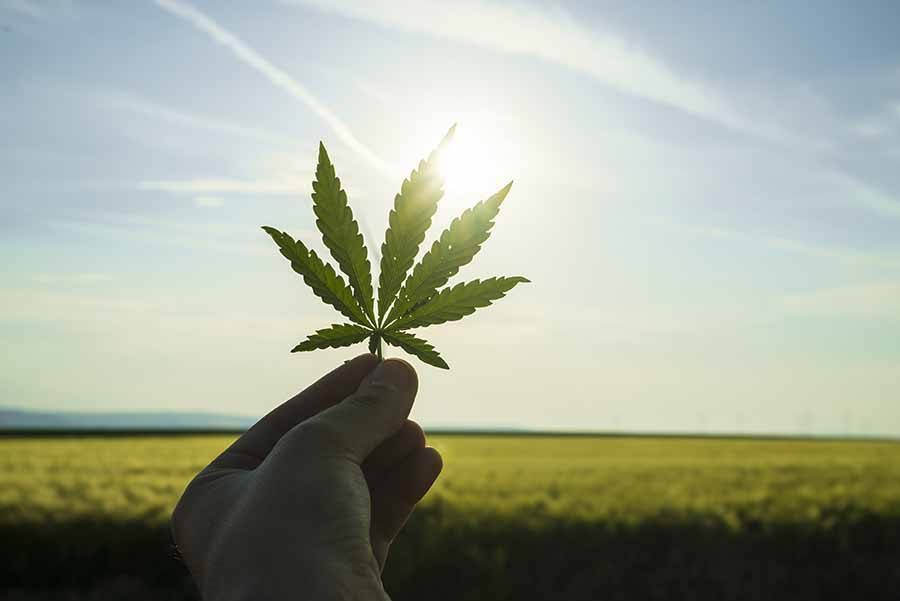Why Does it Taste So Good? – Understanding the Terpene Flavor Wheel
What Are Terpenes?
The cannabis plant is loved around the world for its distinct smell. When opening a bag of cannabis or smelling a field of crops, the aromatic compounds are one of the biggest reasons people are drawn to it. Cannabis plants contain aromatic oils that provide each strain with its distinct smell and flavor. These organic compounds remain hidden in the glands responsible for cannabinoid production and appear to play a role in providing the effects of each unique strain. For instance, certain terpenes leave the user feeling stress-free and relaxed. Other terpenes leave the person more focused. Cannabis cultivars are now so wide spread, there seems to be a terpene profile for everyone’s preference. Most people have used essential oils before. These are packed with the terpenes found on the plants they are created from.
Other plants besides cannabis produce terpenes. In fact, every plant produces terpenes. This helps to explain why certain strains come with a cherry flavor, or a citrus flavor, for instance. The cannabis plant that produces a cherry smell and the cherry plant include the same terpenes. Combining terpenes allows individuals to create unique smells and tastes. In cannabis, terpenes affect not only the smell and taste of the plant, but the therapeutic properties as well. Therapeutic qualities such as the plants natural antioxidant properties are largely due to its terpenes. Anti anxiety properties can come from not only cannabinoids, but the terpene profiles found in different cannabis strains.
The plants produce terpenes to lure pollinators while repelling predators that could do them harm. Terpenes ability to attract insects that are beneficial are a large part of their reason for production. Several factors play a role in which terpenes the plant develops. This includes the climate in which the grower cultivates the plant, the weather, the age of the plant and its maturity, the medium chosen by the grower, and any fertilizers used during development.
Terpenes in Cannabis Plants
Researchers have discovered over 100 unique terpenes in cannabis plants. Each strain features a distinct terpene composition and type, and these terpenes appear in a variety of products. Unique combinations continue to evolve as plant genetics are crossed and mixed.
Most people associate certain characteristics with Indica strains and different ones with Sativa strains. However, researchers believe both cannabinoids and terpenes play a significant role in the effects provided by the strain more than whether it falls into the Indica or Sativa category. They have yet to reach any definitive conclusions though and continue to study this theory.
Furthermore, they need to know more about the entourage effect. They are studying whether a terpene’s effect profile changes when it comes into contact with other compounds like cannabinoids. Terpenes produce many desired effects in the consumption of cannabis, and are a major component to the Entourage Effect. It is widely known that most terpenes have anti inflammatory effects, even outside of cannabis in natural products such as essential oils or medicinal herbs.
Distinctions between terpenes are often subtle, and this adds to the art and connoisseurship associated with cannabis use. In addition, therapeutic value may come with many terpenes, depending on their properties, and which cannabinoids are present on any given strain.
Terpene Chemistry
Terpene molecules come in two basic types. Scientists consider monoterpenes light terpenes, which includes common varieties such as Limonene and Myrcene. They provide floral scents like apple and rose. Sesquiterpenes, in contrast, serve as heavy terpenes and provide a pungent aroma. Both can lead to the aroma and flavor found in cannabis strains. What are some common terpenes one might encounter on cannabis?
Myrcene
Myrcene comes with an aroma many individuals love. It’s the musky, earthy, herbal smell of cloves and cardamom. The terpene converts to vapor at 332 degrees Fahrenheit, and people choose strains with this terpene as they desire the relaxing and sedating effects. Myrcene is also touted for its anti inflammatory and pain reliever effects. Most strains have either myrcene or caryophyllene as a part of their basic structure.
Limonene
Limonene features a citrus aroma and vaporizes when it reaches 348 degrees Fahrenheit. People choose strains with this limonene when they want stress relief or wish to elevate their mood. Strains like Sour Diesel are prominent in Limonene. Citrus fruits are typically always high in limonene for reference.
Caryophyllene
If you prefer woody and spicy strains, ones that bring to mind cloves or black pepper, look no further than products that contain Caryophyllene terpenes. This terpene vaporizes at only 266 degrees Fahrenheit. One benefit of Caryophyllene terpenes is they can provide relaxation, something many individuals seek out today. It’s also known for its anti inflammatory properties.
Terpinolene
Piney, floral, and herbal aromas serve as the fundamental characteristics of Terpinolene terpenes. They uplift the user when they vaporize at 366 degrees Fahrenheit.
Pinene
As the name suggests, Pinene comes with a pine scent, one that can be incredibly uplifting. The most commonly known plant with pinene present are pine trees. Individuals who are struggling with THC effects often turn to strains containing Pinene terpenes because they may offer mitigation. This terpene vaporizes when it reaches 311 degrees Fahrenheit. Strains like Sour Diesel, Blue Dream, and Cotton Candy Kush are high in Pinene. There is also a sub terpene of pinene called beta pinene, which is similar but has it’s own properties.
Humulene
Humulene terpenes feature a woody, earthy aroma, one that brings to mind hops. This terpene vaporizes at a low temperature of 222 degrees Fahrenheit.
Ocimene
The sweet, woody and herbal aroma of Ocimene terpenes attracts many individuals. The terpene comes with many potential therapeutic benefits. Furthermore, it vaporizes at only 122 degrees Fahrenheit.
Linalool
Made famous in lavender, linalool must reach 388 degrees Fahrenheit before it vaporizes. Individuals turn to it when they wish to enhance their mood or feel calmer. This is due in part to its anti inflammatory properties.
How to Protect Terpenes
People must protect the terpenes so they don’t lose any of their flavors. Avoid plastic bags when storing cannabis. Otherwise, air, light, moisture, heat, and cold could damage the cannabis. Sealable bags are also of little help. Plastic comes with a static charge that draws the terpenes and trichomes from the cannabis and deposits them in the plastic. This leaves the buyer with a fine powdery mix of cannabis they cannot remove from the bag to use. Any the user removes from the plastic bag lacks the flavor profile and medicinal benefits the cannabis might provide.
Use glass to keep air away from the cannabis. Glass won’t pull the terpenes and trichomes from the cannabis either, and it helps to preserve the desired moisture level, which is of great importance. Excess moisture leads to mildew growth. Not enough moisture and the cannabis will be dry and brittle, much like twigs that easily snap. Store the glass jars in a dark and dry place. Furthermore, keep the jars full. Any extra space in the jar leaves room for air and moisture.
Conclusion
Every strain of cannabis comes with unique characteristics. Cannabis connoisseurs state the cannabis flavor body adds to the overall experience. For this reason, folks need to know which terpenes are present in the strain they select. This ensures they get a taste and aroma they love without missing out on any expected benefits.
Final thoughts on understanding cannabis terpenes
Now that you know more about cannabis terpenes and can use your knowledge to more deeply enjoy a huge range of CBD, CBG and CBN products.
Want more info? Check out our Guide To Cannabis Derived Terpenes!
Disclaimer – Information is provided for educational purposes. It does not, and is not intended to, constitute legal advice or medical advice. We attempt to be accurate and up to date but the legality of cannabinoids and the science of cannabis is evolving. The author is neither a lawyer or a legal expert, nor a doctor or medical expert. You should check with your local authorities and medical providers before buying or using any products.
References
- Cannabis Classroom Terpenes
- Cannabis 101: Terpenes – The Flavors of Cannabis Aromatherapy
- Hemp 101
- What Are Terpenes In Hemp?
Frequently Asked Questions
Is It legal To Send CBD In The Mail?
Yes, but even though these products are federally-compliant, individual states may have their own regulations about purchasing or using hemp-based products, and these are subject to change. You should check your state and local rules before ordering. We ship nationwide.
What Does "Hemp-Derived" Mean?
Hemp-derived means made from hemp, sometimes also referred to as industrial hemp. The 2018 Farm Bill (see next section) established new federal legal definitions and rules for hemp, including that hemp and “and any part of that plant, including the seeds thereof and all derivatives, extracts, cannabinoids, isomers, acids, salts, and salts of isomers, whether growing or not, with a delta-9 tetrahydrocannabinol concentration of not more than 0.3 percent on a dry weight basis” may be used for production, sales, transport, and use.
Are Hemp Products Safe?
Yes, hemp and hemp derived products are safe when they are produced with proper and safe practices. Look for a product’s COA. A certificate of analysis (COA) is a document attesting to a product’s laboratory analysis and testing for cannabinoids and adulterants.
What Is A COA?
A certificate of analysis (COA) is a document attesting to a product’s laboratory analysis for cannabinoids and in some cases adulterants, heavy metals and pesticides.It is a useful tool for cannabis producers and customers to ensure quality and trust.






